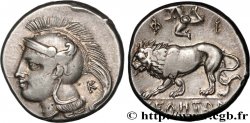bgr_512937 - LUKANIEN - VELIA Nomos, statère ou didrachme
Nicht verfügbar.
Artikel auf unserem Online-Shop verkauft (2020)
Preis : 520.00 €
Artikel auf unserem Online-Shop verkauft (2020)
Preis : 520.00 €
Type : Nomos, statère ou didrachme
Datum: c. 305/304-293/290 AC.
Name der Münzstätte / Stadt : Vélia, Lucanie
Metall : Silber
Durchmesser : 22 mm
Stempelstellung : 12 h.
Gewicht : 7,41 g.
Seltenheitsgrad : R1
Kommentare zum Erhaltungszustand:
Exemplaire sur un flan ovale, bien centré des deux côtés. Belle tête d’Athéna à l’usure régulière. Frappe un peu molle au revers. Patine grise de collection
N° im Nachschlagewerk :
Vorderseite
Titulatur der Vorderseite ANÉPIGRAPHE.
Beschreibung Vorderseite Tête d'Athéna à droite, coiffée du casque attique à cimier avec triple aigrette, orné d’une aile et d’une couronne d’olivier.
Legende des Averses AH/ F
Rückseite
Beschreibung Rückseite Lion passant à droite ; épi de blé au-dessus.
Legende des Reverses : UELHTWN/ F-I/ G
Übersetzung der Rückseite (de Vélia).
Kommentare
Très tôt, le monnayage de Vélia a été décrit comme ayant inspiré la drachme lourde de Marseille (LT. 785-791). Certains l’ont même décrit comme un monnayage symmachique : un lion de Vélia étant l’équivalent de deux lions de Marseille. Aujourd’hui, cette théorie est remise en cause, par G. Depeyrot, non sans arguments, mais avec une certaine acrimonie. Le lion de Vélia a pu servir de modèle à celui de Marseille, mais à quelle date ? La frappe à Vélia commence dans la seconde moitié du Ve siècle avant J.-C. pour se poursuivre jusqu’en 281 avant J.-C. À quel moment les Massaliotes auraient-ils empruntés le lion de Vélia ?.
Very early on, the coinage of Velia was described as having inspired the heavy drachma of Marseille (LT. 785-791). Some have even described it as a symmachic coinage: a lion of Velia being the equivalent of two lions of Marseille. Today, this theory is called into question by G. Depeyrot, not without arguments, but with a certain acrimony. The lion of Vélia could have served as a model for that of Marseille, but at what date? The minting at Velia began in the second half of the 5th century BC and continued until 281 BC. When would the Massaliotes have borrowed the lion from Velia?
Very early on, the coinage of Velia was described as having inspired the heavy drachma of Marseille (LT. 785-791). Some have even described it as a symmachic coinage: a lion of Velia being the equivalent of two lions of Marseille. Today, this theory is called into question by G. Depeyrot, not without arguments, but with a certain acrimony. The lion of Vélia could have served as a model for that of Marseille, but at what date? The minting at Velia began in the second half of the 5th century BC and continued until 281 BC. When would the Massaliotes have borrowed the lion from Velia?








 Berichten über einen Fehler
Berichten über einen Fehler Die Seite drucken
Die Seite drucken Teilen meiner Auswahl
Teilen meiner Auswahl Stellen Sie eine Frage
Stellen Sie eine Frage Einlieferung/Verkauf
Einlieferung/Verkauf
 Details
Details









